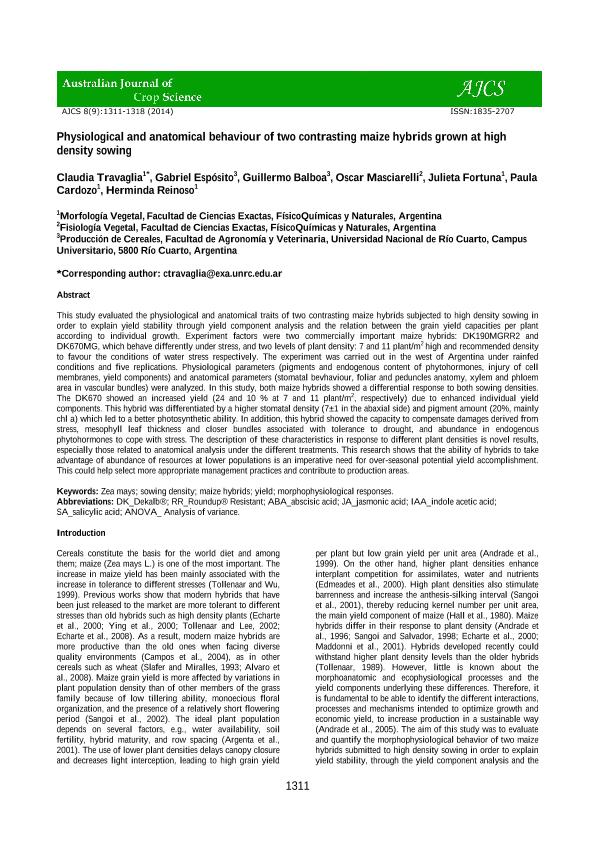Artículo
Morphophysiological behaviour and performance of modern maize hybrids grown at different plant densities
Travaglia, Claudia Noemi ; Espósito, Gabriel Pablo; Balboa, Guillermo Raul; Masciarelli, Oscar Alberto
; Espósito, Gabriel Pablo; Balboa, Guillermo Raul; Masciarelli, Oscar Alberto ; Fortuna, Julieta Belén; Cardozo, Paula Gabriela
; Fortuna, Julieta Belén; Cardozo, Paula Gabriela ; Reinoso, Herminda Elmira
; Reinoso, Herminda Elmira
 ; Espósito, Gabriel Pablo; Balboa, Guillermo Raul; Masciarelli, Oscar Alberto
; Espósito, Gabriel Pablo; Balboa, Guillermo Raul; Masciarelli, Oscar Alberto ; Fortuna, Julieta Belén; Cardozo, Paula Gabriela
; Fortuna, Julieta Belén; Cardozo, Paula Gabriela ; Reinoso, Herminda Elmira
; Reinoso, Herminda Elmira
Fecha de publicación:
09/2014
Editorial:
Southern Cross Publishing
Revista:
Australian Journal of Crop Science
ISSN:
1835-2693
e-ISSN:
1835-2707
Idioma:
Inglés
Tipo de recurso:
Artículo publicado
Clasificación temática:
Resumen
This study evaluated the physiological and anatomical traits of two contrasting maize hybrids subjected to high density sowing in order to explain yield stability through yield component analysis and the relation between the grain yield capacities per plant according to individual growth. Experiment factors were two commercially important maize hybrids: DK190MGRR2 and DK670MG, which behave differently under stress, and two levels of plant density: 7 and 11 plant/m2 high and recommended density to favour the conditions of water stress respectively. The experiment was carried out in the west of Argentina under rainfed conditions and five replications. Physiological parameters (pigments and endogenous content of phytohormones, injury of cell membranes, yield components) and anatomical parameters (stomatal bevhaviour, foliar and peduncles anatomy, xylem and phloem area in vascular bundles) were analyzed. In this study, both maize hybrids showed a differential response to both sowing densities. The DK670 showed an increased yield (24 and 10 % at 7 and 11 plant/m2 , respectively) due to enhanced individual yield components. This hybrid was differentiated by a higher stomatal density (7±1 in the abaxial side) and pigment amount (20%, mainly chl a) which led to a better photosynthetic ability. In addition, this hybrid showed the capacity to compensate damages derived from stress, mesophyll leaf thickness and closer bundles associated with tolerance to drought, and abundance in endogenous phytohormones to cope with stress. The description of these characteristics in response to different plant densities is novel results, especially those related to anatomical analysis under the different treatments. This research shows that the ability of hybrids to take advantage of abundance of resources at lower populations is an imperative need for over-seasonal potential yield accomplishment. This could help select more appropriate management practices and contribute to production areas.
Palabras clave:
Zea Mays
,
Sowing Density
,
Maize Hybrids
,
Yield
,
Morphophysiological Responses
Archivos asociados
Licencia
Identificadores
Colecciones
Articulos(CCT - CORDOBA)
Articulos de CTRO.CIENTIFICO TECNOL.CONICET - CORDOBA
Articulos de CTRO.CIENTIFICO TECNOL.CONICET - CORDOBA
Citación
Travaglia, Claudia Noemi; Espósito, Gabriel Pablo; Balboa, Guillermo Raul; Masciarelli, Oscar Alberto; Fortuna, Julieta Belén; et al.; Morphophysiological behaviour and performance of modern maize hybrids grown at different plant densities; Southern Cross Publishing; Australian Journal of Crop Science; 8; 9; 9-2014; 1311-1318
Compartir



